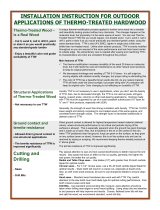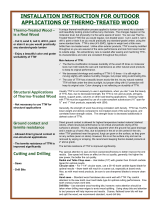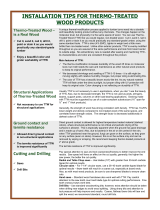Page is loading ...

Parameter Effect Comments
Equilibrium
moisture
Reduced 50% compared untreated
wood. The difference is higher, the
relative humidity is higher.
This difference remained after years of exposure. After thermo
treatment the wood is dry - moisture content is 4-6%.
Dimensional
stability
The swelling and shrinkage (both
tangential and radial) reduces 3-5 times
for softwoods and up to 15 times for
hardwoods. This parameter is strongly
depends on the relative humidity (at
100% reduces 2 times for softwoods and
3-5 times for hardwoods)
This because of the decrease in absorptive qualities, lower equi-
librium moisture content and also due to lignin depolymerization
the length of chains of cellulose decreases and this leads to the
deformations decrease.
Color Attractive golden brown appearance and
even color at all depth.
The color is affected by the treatment temperature and time. It is
possible to receive several gradations of color based on the
process.
Appearance Attractive golden brown appearance and
even color at all depth. Color becomes
more sated and homogeneous on all
section; the structure of wood effectively
comes to light.
The color is affected by the treatment temperature and time. It is
possible to receive several gradations of color based on the
process. The effect of valuable breeds of wood is reached.
Density Lower density at 5-10%. Due to the emissions during the thermo-treatment process and
lower equilibrium moister content. This feature might improve the
cost-efficiency of shipping of the treated material.
Cell structure Changes as if after ageing for 120-250
years.
The color is affected by the treatment temperature and time. It is
possible to receive several gradations of color based on the
process. The effect of valuable breeds of wood is reached while
the absorption of moisture is decreased.
Resin Is almost fully removed.
Brinell hardness Increases as the treatment temperature
increases. However, the relative change
is very small, as the density decreases.
Certain kinds of timber change their place on the hardness scale,
as some of them become harder, while others softer as a result of
the treatment temperature and specie.
Permeability The water uptake reduced up to 5 times
depending on treatment temperature.
The surface of the thermo-treated wood is not porous but solid,
also the chemical composition of the wood changes. Reduced
water absorption has to be taken into account when working with
water solvent glue or paint.
Thermal
conductivity
Decreased by 10-30%. Thanks to the lower water content and structural changes.
Fire resistance The same as non-treated wood.
Thermo--treated wood is in fire class D.
The time of ignition a little decreased, but better than the normally
dried softwoods in terms of heat and smoke release.
Resistance to
insect attack
and termites
Significantly increased resistance to the
hardwood and softwood insects, but only
a little increased resistance to the
termites (it is expected that termites will
choose normal wood over thermo-
treated).
Tests have been carried out in Europe to evaluate the resistance
to attack from the three most common wood boring insects found
in Europe. House Longhorn beetles (Hylotrupes bajulus) are found
in the sapwood of softwood, the common furniture beetle
(Anobium punctatum) preferentially attacks hardwoods and the
Powderpost beetle (Lyctus brunneus) is found in some hardwood
species. The results of the tests found that Thermo-treated wood
was resistant to all three of the above insect species. Southern
European Subterranean termites (Reticulitermes spp) found in
Europe only attack buildings from the earth below, avoid-ing direct
sunlight where possible. Termites will attack both wood and
concrete based materials in their quest for a strong food base.
Various measures have been developed to control the problem
including polythene membranes being installed in the foundations
and various bituminous paint products are available to seal
possible routes up the building.
Rot resistance Improved. However it is not suitable for conditions where it would be satu-
rated with water or in prolonged contact with damp ground.
MAJOR FEATURES OF THERMO-TREATED WOOD

Parameter Effect Comments
Biological
durability
European tests on biological durability
of Thermo-treated wood in EN 113,
ENV 807 standards showed
significantly improved level of
resistance against fungi attack (15-25
times) depending on treatment
temperature.
Thermo-treated wood does not require any chemical protection. Due to
high heat of processing in wood decay hemi-cellulose and poly-sugars,
that on a background of low equilibrium humidity eliminates conditions
for occurrence and duplication of a fungus and microorganisms.
Biodamaging agents (insects and those larvae, bacteria, fungi and
their disputes) are destroyed. According to tests the wood, treated at
410F should obtain dura-bility class 2; upper 430F with 3 hours of
treatment is class 1 (30 years service life outdoor). The best results
can be achieved when the material is used in above ground
applications with good ventilation and no water-trapping.
Weather
resistance
Being a natural material exposed to
weather effects (ultraviolet radiation
and rain) it will start to grey without
coating in approximately one summer.
When left without surface protection
small surface shakes can also
appear.
As the thermo-treated wood has even brown color in depth, the original
color can be easily restored by simply sanding the surface. Or
recommended to apply a pigment based surface protection to prevent
color changes and surface shakes. Strongly recommended apply of
high-build stains and oils protected (the best are priming oil and
solvent-based alkyd or water-based acrylic topcoat), otherwise the low-
build coatings wore away and annual rings started to loosen just as in
the panels without coating. The panels coated with the low-build stains
showed a strong tendency to crack. Due to bacteria in the air or dirt
carried in the rain, fungi can grow on the untreated surface. However,
this is on the surface only and can be removed by wiping or scraping.
Ground
contact
Not recommended to be used in deep
ground applications where structural
performance is required.
It is assumed that the indicated loss of strength is due to moisture and
to any micro-organism. However practical experience has found that
usage of highest temperature treated material in ground contact where
structural performance is not critical and periodic drying of the surfaces
is allowed does not cause any significant deterioration to the material.
This is especially apparent when the ground has good drainage and is
made up of sand or shingle.
Emissions Total volatile organic compounds are
significantly lower (250-800 mg/m2h)
than with normal kiln dried material
(1500 mg/m2h).
The most of thermo-treated wood emission is acetic acid (110 mg/
m2h). The smoke-like smell that comes out of thermo-treated wood
(most likely comes from furfural) disappears almost totally with time or
after coating.
Environmental
purity
Absolutely. The thermo-treatment is made without insertion of any chemicals. With
guarantees at least the same class of durability as the chemically
protected wood, thermo-treated wood holds no danger for the
environment.
Utilization Needs no additional conservation Can be easily utilized at the end of its life cycle unlike the chemically
treated lumber.
General
strength
Reduced proportionally the density
reduction.
Generally the strength of wood has strong correlation with density.
Thermo-treated wood has slightly lower density and correlated lower
strength values, but weight-strength-value can be practically
unchanged.
Bending
strength
Lower (1-30%) especially for lumber
with knots and highly depends on
treatment temperature.
It is recommended that deep Thermo-treated wood is NOT used for
load bearing structural usage. On the other hand, it was found that the
light treatment renders positive influence on elasticity of molecules of
wood.
Dynamic
bending
strength
Lower (1-25%) especially for lumber
with knots and highly depends on
treatment temperature.
Compression
strength
The thermo-treatment process has no
negative effect on the compression
strength values.
This property depends mainly on density of wood. Moreover, in some
cases results better, than for dried up wood.
Shear strength Radial values reduced 1-25 percent
and tangential values 1-40 percent.
Highly depends on treatment temperature.
Splitting
strength
Reduces 20-40 percent depending on
treatment temperature.
Hardwoods show better results than softwoods.
Screw holding
strength
Bigger effect on screw holding
strength comes from the general
variance in wood density than
thermo-treatment process.
It was found that the results were better when narrower pre-drill holes
were used for material with lower density.
www.thermotreatedwood.com
/








